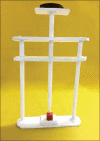Comparative analysis of shear bond strength of lithium disilicate samples cemented using different resin cement systems: An in vitro study
- PMID: 31462863
- PMCID: PMC6685336
- DOI: 10.4103/jips.jips_161_19
Comparative analysis of shear bond strength of lithium disilicate samples cemented using different resin cement systems: An in vitro study
Abstract
Aim: This study aims to evaluate and compare the shear bond strength (SBS) of three different resin cements - total etch and rinse, self-etch and self-adhesive resin cements, used to bond the lithium disilicate restorations to human dentin.
Settings and design: Comparative -Invitro study design.
Materials and methods: Forty-five lithium disilicate (IPS E.max) discs (4 mm in diameter and 3 mm thick) were fabricated and randomly divided into three groups (n = 15). The occlusal surfaces of 45 extracted human maxillary premolars were ground flat. Fifteen specimens were luted, under a constant load, with each of the following resin cement: Variolink N (Group VN), Multilink N (Group MN), and Multilink Speed (Group MS). All cemented specimens were stored in distilled water for 1-week following which, they were tested under shear loading at a constant crosshead speed of 1 mm/min until fracture on a universal testing machine; the load at fracture was reported in megapascals (MPa) as the bond strength. Fractured specimens were also inspected by the scanning electron microscopy. Statistical analysis of the collected data was performed using one-way ANOVA test, post hoc Bonferroni test, and Chi-square test (α =0.05).
Statistical analysis used: Oneway ANOVA test and post hoc Bonferroni test.
Results: Mean SBS data of the groups in MPa were: Variolink N (Group VN): 14.19 ± 0.76; Multilink N (Group MN): 10.702 ± 0.75; and Multilink Speed (Group MS): 5.462 ± 0.66. Significant differences in SBS (P < 0.001) of the three resin cement were found. Intergroup comparison revealed statistically significant differences in SBS between Groups VN and MN (P < 0.001), Groups B and C (P < 0.001), and Groups VN and MS (P < 0.001). Chi-square test used to compare the distribution of mode of bond failure among the three groups delineated that the cohesive failure was significantly more among Group VN, whereas adhesive failure was significantly more among Group MN and MS.
Conclusion: Total etch and rinse resin cement, i.e., Variolink N (Group VN) produced significantly higher bond strength of all-ceramics to dentin surfaces than did the self-etch and self-adhesive resin cements, i.e., Multilink N and Multilink Speed, respectively.
Keywords: Self-adhesive resin cement; self-etch resin cement; total-etch resin cement.
Conflict of interest statement
There are no conflicts of interest.
Figures









References
-
- Ritter RG. Multifunctional uses of a novel ceramic-lithium disilicate. J Esthet Restor Dent. 2010;22:332–41. - PubMed
-
- Sato T, Cotes C, Yamamoto LT, Rossi NR, Macedo VC, Kimpara ET. Flexural strength of a pressable lithium disilicate ceramic: Influence of surface treatments. Appl Adhes Sci. 2013;1:7.
-
- Begazo CC, de Boer HD, Kleverlaan CJ, van Waas MA, Feilzer AJ. Shear bond strength of different types of luting cements to an aluminum oxide-reinforced glass ceramic core material. Dent Mater. 2004;20:901–7. - PubMed
-
- Lise DP, Perdigão J, Van Ende A, Zidan O, Lopes GC. Microshear bond strength of resin cements to lithium disilicate substrates as a function of surface preparation. Oper Dent. 2015;40:524–32. - PubMed
LinkOut - more resources
Full Text Sources
